
Author: Jacob Zhao @IOSG
Robot Panorama: From Industrial Automation to Humanoid Intelligence
The traditional robot industry chain has formed a complete layered system from bottom to top, coveringCore components—intermediate control system—complete machine manufacturing—application integrationFour major links.Core components(Controller, servo, reducer, sensor, battery, etc.) The technical barrier is the highest, which determines the lower limit of the overall machine performance and cost;control systemIt is the “brain and cerebellum” of the robot, responsible for decision-making, planning and movement control;Whole machine manufacturingReflect supply chain integration capabilities.System integration and applicationDetermining the depth of commercialization is becoming the new core of value.
According to application scenarios and forms, global robots are following the “Industrial automation → Scenario intelligence → General intelligence“The path evolution has formed five main types:Industrial robots, mobile robots, service robots, special robots and humanoid robots
#industrial robot(Industrial Robots)
Currently the only comprehensive and mature track, it is widely used in manufacturing processes such as welding, assembly, spraying and handling.The industry has formed a standardized supply chain system, with stable gross profit margin and clear ROI.One of the subcategories, collaborative robots (Cobots), emphasizes human-machine collaboration, is lightweight and easy to deploy, and is growing the fastest.
Representative enterprise:ABB, Fanuc, Yaskawa, KUKA, Universal Robots, Jieka, Aobo.
#mobile robot(Mobile Robots)
Including AGV (automatic guided vehicle) and AMR (autonomous mobile robot), they have been implemented on a large scale in logistics warehousing, e-commerce distribution and manufacturing transportation, and have become the most mature categories on the B-side.
Representative enterprise: Amazon Robotics, Geek+, Quicktron, Locus Robotics.
#service robot(Service Robots)
Targeting industries such as cleaning, catering, hotels and education, it is the fastest growing area on the consumer side.Cleaning products have entered the logic of consumer electronics, and medical and commercial distribution are accelerating commercialization.In addition, a number of more general-purpose operating robots are emerging (such as Dyna’s dual-arm system)—more flexible than task-specific products, but not yet as versatile as humanoid robots.
Representative enterprise: Ecovacs, Roborock Technology, Pudu Technology, Qinglang Intelligence, iRobot, Dyna, etc.
#Special robot
It mainly serves scenarios such as medical care, military industry, construction, marine and aerospace. The market size is limited but the profit margin is high and the barriers are strong. It relies mostly on government and corporate orders and is in the vertical segmentation growth stage.Typical projects includeIntuitive Surgical, Boston Dynamics, ANYbotics, NASA Valkyrie, and more.
#humanoid robot(Humanoid Robots)
Considered as the “universal workforce platform” of the future.
Representative enterprise:Tesla (Optimus), Figure AI (Figure 01), Sanctuary AI (Phoenix), Agility Robotics (Digit), Apptronik (Apollo), 1X Robotics, Neura Robotics, Unitree, UBTECH, Zhiyuan Robot, etc.
Humanoid robots are the frontier direction that attracts the most attention at the moment. Its core value lies in adapting humanoid structures to existing social spaces and is regarded as a key form leading to a “universal labor platform.”Unlike industrial robots that pursue extreme efficiency, humanoid robots emphasizeGeneral adaptability and task transferability, can enter factories, homes and public spaces without modifying the environment.
Currently, most humanoid robots are still stuck intechnology demonstration stage, mainly verifying dynamic balance, walking and operating abilities.Although there are already some projects inhighly controlledSmall-scale deployments (such as Figure × BMW, Agility Digit) have begun in factory scenarios, and it is expected that more manufacturers (such as 1X) will enter early distribution from 2026, but these are stillRestricted application of “narrow scene, single task”, rather than the implementation of a universal labor force in the true sense.Overall, it will still take several years before large-scale commercialization.Core bottlenecks include: control problems such as multi-degree-of-freedom coordination and real-time dynamic balance; energy consumption and battery life issues limited by battery energy density and driving efficiency; perception-decision-making links that are prone to instability and difficult to generalize in an open environment; significant data gaps (difficult to support general strategy training); cross-body migration has not yet been overcome; and hardware supply chains and cost curves (especially outside China) still constitute realistic thresholds, making it more difficult to achieve large-scale, low-cost deployment.
The future commercialization path is expected to go through three stages: short-term andDemo-as-a-ServiceMainly, relying on pilot projects and subsidies; in the medium term, it will evolve toRobotics-as-a-Service (RaaS), build an ecology of tasks and skills; long-termWorkforce CloudwithSmart subscription serviceAs the core, we promote the shift of value focus from hardware manufacturing to software and service networks.Generally speaking, humanoid robots are in a critical transition period from demonstration to self-learning. Whether they can cross the triple threshold of control, cost and algorithm in the future will determine whether they can truly realize embodied intelligence.
AI × Robots: The Dawn of the Embodied Intelligence Era
Traditional automation mainly relies on pre-programming and pipeline control (such as the DSOP architecture of sensing-planning-control) and can only run reliably in a structured environment.The real world is more complex and changeable, and the new generation of embodied intelligence (Embodied AI) follows another paradigm: through large models and unified representation learning, robots have the ability to “understand-predict-act” across scenarios.Embodied Intelligence EmphasisBody (hardware) + brain (model) + environment (interaction)Dynamic coupling, the robot is the carrier, and intelligence is the core.
Generative AI belongs toIntelligence in the world of language, good at understanding symbols and semantics; Embodied AI belongs toreal world intelligence, master perception and action.The two correspond to “brain” and “body” respectively, representing two parallel main lines of AI evolution.From an intelligence level perspective, embodied intelligence is more advanced than generative AI, but its maturity is still significantly behind.LLM relies on the massive corpus of the Internet to form a clear closed loop of “data → computing power → deployment”; while robot intelligence requiresFirst perspective, multi-modal, data strongly bound to actions——Including remote control trajectories, first-person perspective videos, spatial maps, operation sequences, etc. These dataDoes not exist naturally, must be generated through real interaction or high-fidelity simulation, and are therefore more scarce and expensive.Although simulation and synthetic data are helpful, they still cannot replace real sensor-motion experience. This is why Tesla, Figure, etc. must build their own remote operation data factories, and also why third-party data annotation factories appear in Southeast Asia.In short:LLM learns from readily available data, whereas robots must “create” data by interacting with the physical world.In the next 5–10 years, the two will be deeply integrated on the Vision–Language–Action model and the Embodied Agent architecture—LLM is responsible for high-level cognition and planning, and the robot is responsible for real-world execution, forming a two-way closed loop of data and action, jointly promoting AI from “linguistic intelligence” to realGeneral Intelligence (AGI).
The core technology system of embodied intelligence can be regarded as a bottom-up intelligence stack:VLA (perception fusion), RL/IL/SSL (intelligent learning), Sim2Real (reality transfer), World Model (cognitive modeling), and multi-agent collaboration and memory reasoning (Swarm & Reasoning).Among them, VLA and RL/IL/SSL are the “engines” of embodied intelligence, which determine its implementation and commercialization; Sim2Real and World Model are key technologies that connect virtual training and real-world execution; multi-agent collaboration and memory reasoning represent higher-level group and metacognitive evolution.
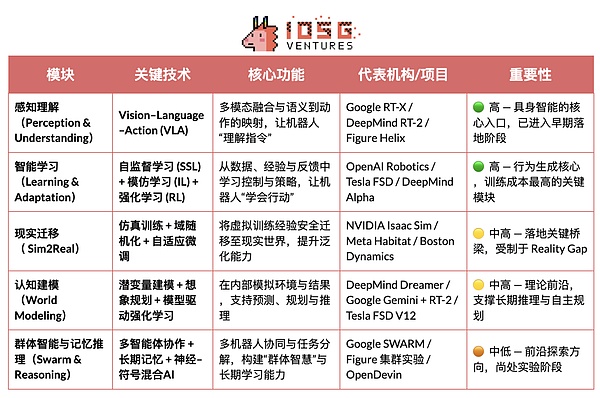
Perceptual understanding: Vision–Language–Action model (Vision–Language–Action)
The VLA model integratesVision—Language—ActionThree channels enable the robot to understand intentions from human language and translate them into specific operating behaviors.Its execution process includes semantic parsing, target recognition (locating target objects from visual input), path planning and action execution, thereby achieving a closed loop of “understanding semantics – perceiving the world – completing tasks”, which is one of the key breakthroughs in embodied intelligence.The current representative projects includeGoogle RT-X, Meta Ego-Exo and Figure Helix, respectively demonstrating cutting-edge directions such as cross-modal understanding, immersive perception and language-driven control.
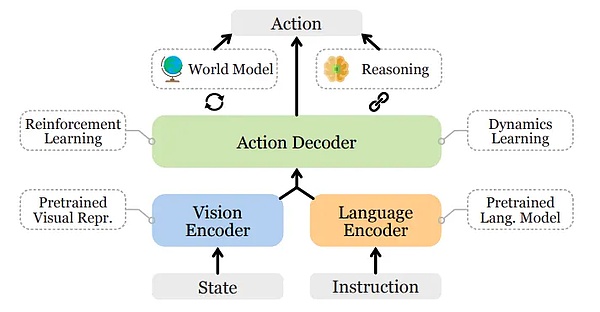
Currently, VLA is still in its early stages and faces four core bottlenecks:
-
Semantic ambiguity and weak task generalization: Models have difficulty understanding vague, open-ended instructions;
-
Unstable alignment of vision and movement: Perception errors are amplified in path planning and execution;
-
Multimodal data are scarce and standards are inconsistent: The cost of collection and labeling is high, making it difficult to form a large-scale data flywheel;
-
Time axis and space axis challenges of long-term tasks: Too long a task span leads to insufficient planning and memory capabilities, while too large a spatial range requires the model to reason about things “outside the field of view.” Current VLA lacks stable world models and cross-space reasoning capabilities.
These problems jointly limit the cross-scenario generalization ability and large-scale implementation process of VLA.
Intelligent learning: self-supervised learning (SSL), imitation learning (IL) and reinforcement learning (RL)
-
self-supervised learning(Self-Supervised Learning): Automatically extract semantic features from sensory data to allow robots to “understand the world.”It is equivalent to letting the machine learnObservation and representation.
-
imitation learning(Imitation Learning): Quickly master basic skills by imitating human demonstrations or expert examples.It is equivalent to letting the machine learnact like a human being.
-
reinforcement learning(Reinforcement Learning): Through the “reward-punishment” mechanism, the robot optimizes its action strategy through continuous trial and error.It is equivalent to letting the machine learnGrow through trial and error.
In Embodied AI, self-supervised learning (SSL) aims to allow robots to predict state changes and physical laws through sensory data, thereby understanding the causal structure of the world; reinforcement learning (RL) is the core engine of intelligence formation, driving robots to master complex behaviors such as walking, grabbing, and avoiding obstacles through interaction with the environment and trial-and-error optimization based on reward signals; imitation learning (IL) accelerates this process through human demonstration, allowing robots to quickly acquire action priors.The current mainstream direction is to combine the three to build a hierarchical learning framework: SSL provides a representation basis, IL gives human priors, and RL drives policy optimization to balance efficiency and stability, which together constitute the core mechanism of embodied intelligence from understanding to action.
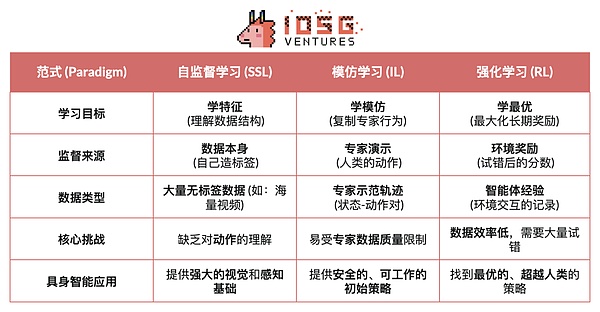
Reality migration: Sim2Real – the leap from simulation to reality
Sim2Real(Simulation to Reality) is to allow robots to complete training in a virtual environment and then migrate to the real world.It uses high-fidelity simulation environments such asNVIDIA Isaac Sim & Omniverse, DeepMind MuJoCo) generates large-scale interactive data, significantly reducing training costs and hardware wear.Its core is to reduce the “simulated reality gap”, the main methods include:
-
domain randomization(Domain Randomization): Randomly adjust lighting, friction, noise and other parameters during simulation to improve model generalization ability;
-
Physical consistency calibration: Use real sensor data to calibrate the simulation engine to enhance physical fidelity;
-
Adaptive fine-tuning(Adaptive Fine-tuning): Perform rapid retraining in the real environment to achieve stable migration.
Sim2Real is the central link in the implementation of embodied intelligence, enabling AI models to learn the closed loop of “perception-decision-control” in a safe and low-cost virtual world.Sim2Real has matured in simulation training (such as NVIDIA Isaac Sim, MuJoCo), but reality migration is still limited by Reality Gap, high computing power and labeling costs, as well as insufficient generalization and security in an open environment.Despite this, Simulation-as-a-Service (SimaaS) is becoming the lightest but most strategically valuable infrastructure in the era of embodied intelligence. Its business model includes platform subscription (PaaS), data generation (DaaS) and security verification (VaaS).
Cognitive modeling: World Model – the “inner world” of the robot
world model(World Model) is the “inner brain” of embodied intelligence, allowing robots to internally simulate the environment and action consequences to achieve prediction and reasoning.It builds a predictable internal representation by learning the dynamic laws of the environment, allowing the agent to “preview” the results before execution, evolving from a passive executor to an active reasoner. Representative projects include DeepMind Dreamer, Google Gemini + RT-2, Tesla FSD V12, NVIDIA WorldSim, etc.Typical technology paths include:
-
Latent variable modeling(Latent Dynamics Modeling): Compress high-dimensional perception into latent state space;
-
Time series prediction imagination training(Imagination-based Planning): Virtual trial and error and path prediction in the model;
-
Model-driven reinforcement learning(Model-based RL): Replace the real environment with a world model to reduce training costs.
World Model is at the theoretical forefront of embodied intelligence and is the core path for robots to move from “reactive” to “predictive” intelligence. However, it is still limited by challenges such as complex modeling, unstable long-term predictions, and the lack of unified standards.
Swarm intelligence and memory reasoning: from individual action to collaborative cognition
Multi-Agent Systems and Memory & Reasoning represent two important directions in the evolution of embodied intelligence from “individual intelligence” to “group intelligence” and “cognitive intelligence”.The two jointly support the intelligent systemcollaborative learningwithlong term adaptationAbility.
#Multi-agent collaboration (Swarm/Cooperative RL):
It refers to the realization of collaborative decision-making and task allocation by multiple agents in a shared environment through distributed or collaborative reinforcement learning.There is a solid research foundation in this direction, such asOpenAI Hide-and-Seek experiment demonstrates multi-agent spontaneous cooperation and strategy emergence, DeepMind QMIX and MADDPG algorithmsProvides a collaborative framework for centralized training and decentralized execution.This type of method has been applied and verified in scenarios such as warehouse robot scheduling, inspection, and cluster control.
#Memory & Reasoning
Focusing on equipping agents with long-term memory, situational understanding and causal reasoning capabilities is a key direction for achieving cross-task transfer and self-planning.typicalResearch includes DeepMind Gato (unified perception-language-control multi-task agent) and DeepMind Dreamer series (imaginative planning based on world model), as well as open embodied agents such as Voyager, which use external memory toAchieve continuous learning with self-evolution.These systems lay the foundation for robots to have the ability to “remember the past and deduce the future.”
Global embodied intelligence industry landscape: cooperation and competition coexist
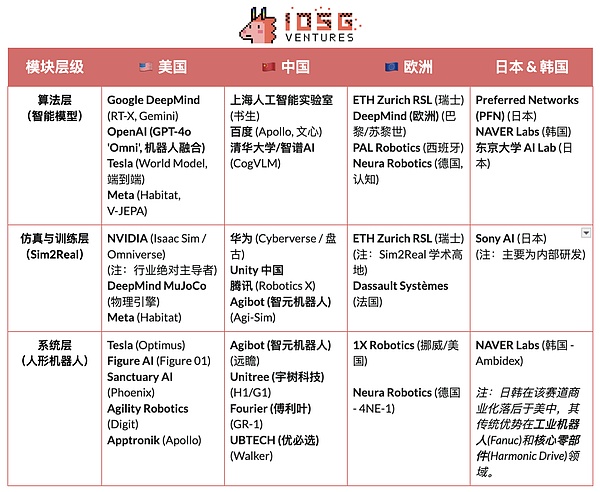
The global robot industry is in a period of “cooperation-led and competition deepening”.China’s supply chain efficiency, the United States’ AI capabilities, Japan’s parts precision, and Europe’s industrial standards will jointly shape the long-term pattern of the global robot industry.
-
USAStay ahead of the curve in cutting-edge AI models and software (DeepMind, OpenAI, NVIDIA), but that advantage doesn’t extend to robotics hardware.Chinese manufacturers have more advantages in iteration speed and real-life scene performance.The United States has promoted the reshoring of industries through the CHIPS Act and the Inflation Reduction Act (IRA).
-
ChinaRelying on large-scale manufacturing, vertical integration and policy-driven development, it has formed leading advantages in the fields of parts, automated factories and humanoid robots, and has outstanding hardware and supply chain capabilities. Yushu and UBTECH have achieved mass production and are extending to the intelligent decision-making level.However, there is still a big gap between China and the United States in terms of algorithms and simulation training.
-
JapanIt has a long-term monopoly on high-precision components and motion control technology, and its industrial system is stable. However, AI model integration is still in its early stages, and the pace of innovation is relatively stable.
-
South KoreaIt is outstanding in the popularization of consumer robots – led by companies such as LG and NAVER Labs, and has a mature and strong service robot ecosystem.
-
EuropeThe engineering system and safety standards are complete, and 1X Robotics and others remain active at the R&D level, but some manufacturing links have been relocated, and the focus of innovation is biased toward collaboration and standardization.
Robot × AI × Web3: Narrative Vision and Realistic Path
In 2025, a new narrative emerges in the Web3 industry that merges with bots and AI.Although Web3 is regarded as the underlying protocol of the decentralized machine economy, its combined value and feasibility at different levels are still clearly differentiated:
-
Hardware manufacturing and service layerCapital-intensive and weak data closed loop, Web3 can currently only play an auxiliary role in edge links such as supply chain finance or equipment leasing;
-
Simulation and software ecosystem layerThe degree of compatibility is high. Simulation data and training tasks can be uploaded to the chain to confirm the rights. Agents and skill modules can also be verified throughNFT or Agent TokenRealize capitalization;
-
platform layer, decentralized labor and collaboration networks are showing their greatest potential – Web3 can gradually build a credible “machine labor market” through an integrated mechanism of identity, incentives and governance, laying the institutional prototype for the future machine economy.
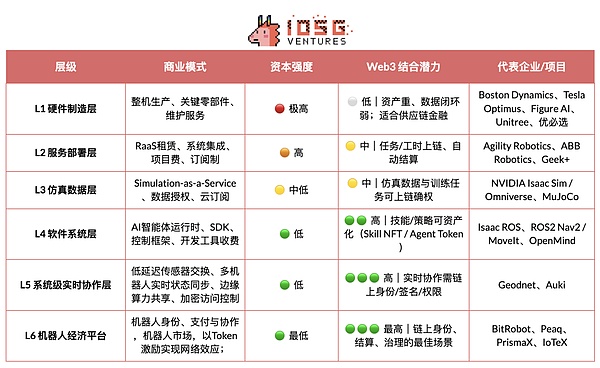
From a long-term perspective,Collaboration and Platform LayerIt is the most valuable direction in the integration of Web3, robots and AI.As robots gradually acquire perception, language and learning capabilities, they are evolving into intelligent individuals capable of autonomous decision-making, collaboration and creation of economic value.These “intelligent workers” still need to cross four boundaries to truly participate in the economic system.Identity, trust, incentives and governancecore threshold.
-
inidentity layer, the machine needs to have a confirmable and traceable digital identity.passThrough Machine DID,Each robot, sensor or drone can generate a unique and verifiable “ID card” on the chain, binding its ownership, behavior records and scope of authority to achieve safe interaction and definition of responsibilities.
-
intrust layer, the key is to make “machine labor” verifiable, measurable, and measurablePricing.With the help of smart contracts, oracles and audit mechanisms, combined with Proof of Physical Work (PoPW), Trusted Execution Environment (TEE) and Zero-Knowledge Proof (ZKP), the authenticity and traceability of the task execution process can be ensured, making machine behavior empirical.Economic accounting value.
-
inIncentive layer, Web3 passesToken incentive system, account abstraction and status channelRealize automatic settlement and value transfer between machines.Robots can complete computing power rental and data sharing through micropayments, and use pledge and penalty mechanisms to ensure task performance; with the help of smart contracts and oracles, a decentralized “machine collaboration market” that does not require manual scheduling can also be formed.
-
inGovernance, when the machine has long-term autonomy capabilities, Web3 provides a transparent and programmable governance framework:Use DAO to govern joint decision-making system parameters, and maintain security and order with multi-signature and reputation mechanisms.In the long term, this will push the machine society towards the stage of “algorithmic governance” – humans set goals and boundaries, and machines use contracts to maintain incentives and balance.
The ultimate vision for the integration of Web3 and robots: real environment evaluation network——A “real-world reasoning engine” composed of distributed robots that continuously tests and benchmarks model capabilities in diverse and complex physical scenarios; andRobot labor market——Robots perform verifiable real-life tasks around the world, earn profits through on-chain settlement, and reinvest the value into computing power or hardware upgrades.
From a practical perspective, the combination of embodied intelligence and Web3 is still in the early exploratory stage, and the decentralized machine intelligence economy remains more at the narrative and community-driven level.In reality, the combination directions with feasible potential are mainly reflected in the following three aspects:
(1)Data crowdsourcing and confirmation of rights——Web3 encourages contributors to upload real-world data through on-chain incentive and traceability mechanisms;
(2)Global long tail participation——Cross-border micropayments and micro-incentive mechanisms effectively reduce data collection and distribution costs;
(3)Financialization and collaborative innovation——The DAO model can promote the assetization of robots, the voucherization of income and the settlement mechanism between machines.
Overall, in the short term, the main focus is onData collection and incentive layer;In the medium term, it is expected to be in “Stable currency payment + long-tail data aggregation“AndRaaS assetization and settlement layerAchieve breakthroughs; in the long term, if humanoid robots are popularized on a large scale,Web3 may become the underlying system for machine ownership, revenue distribution and governance, to promote the formation of a truly decentralized machine economy.
Web3 robot ecological map and selected cases
Based on the three criteria of “verifiable progress, technology openness, and industry relevance”, sort out the currentWeb3 × RoboticsRepresentative projects, classified according to the five-layer structure:Model intelligence layer, machine economic layer, data collection layer, perception and simulation basic layer, and robot asset income layer.In order to remain objective, we have eliminated obvious “hot spots” or items with insufficient information; if there are any omissions, please correct us.
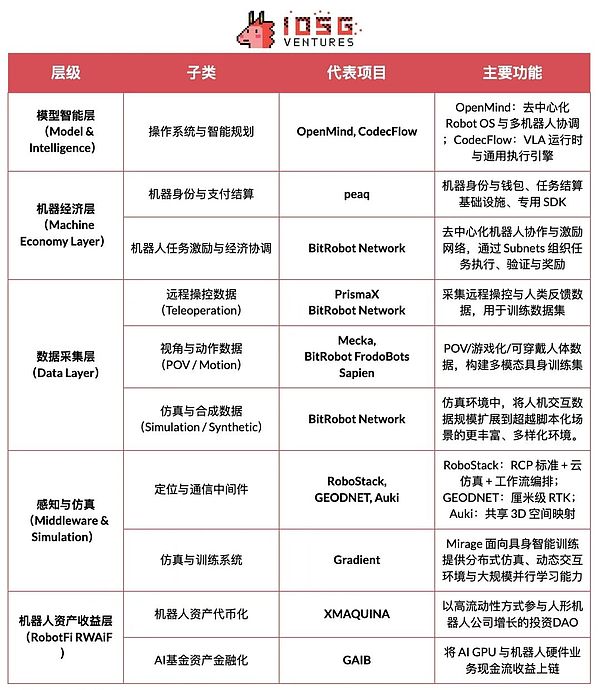
Model & Intelligence
#Openmind – Building Android for Robots
OpenMindIt is an open source operating system (Robot OS) for embodied intelligence (Embodied AI) and robot control. The goal is to build the world’s first decentralized robot operating environment and development platform.The core of the project consists of two major components:
-
OM1: A modular open source AI runtime layer built on ROS2, used to orchestrate perception, planning and action pipelines, serving digital and physical robots;
-
FABRIC: Distributed coordination layer (Fabric Coordination Layer) connects cloud computing power, models and real robots, allowing developers to control and train robots in a unified environment.
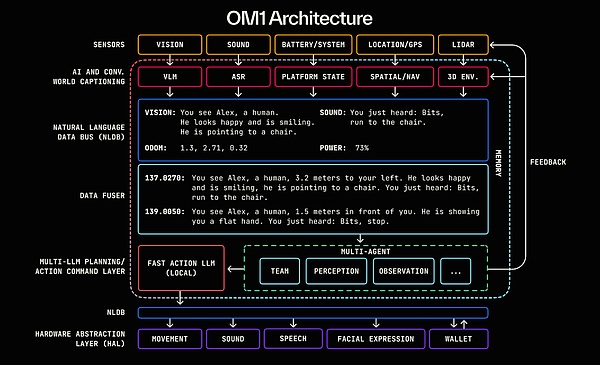
At its core, OpenMind serves asAn intelligent middle layer between LLM (Large Language Model) and the robotic world, allowing language intelligence to truly transform into embodied intelligence (Embodied Intelligence), building fromUnderstand (Language → Action)ArriveAlignment (Blockchain → Rules)intelligent skeleton.
OpenMind multi-layer system achieves a complete collaborative closed loop: humans passOpenMind App provides feedback and annotation (RLHF data), and Fabric Network is responsible forAuthentication, task allocation and settlement protocolstune, OM1 Robots executes the taskservices and follow the “robot constitution” on the blockchain to complete behavioral audits and payments, thereby achievingHuman feedback → Task collaboration → On-chain settlementA decentralized machine collaboration network.
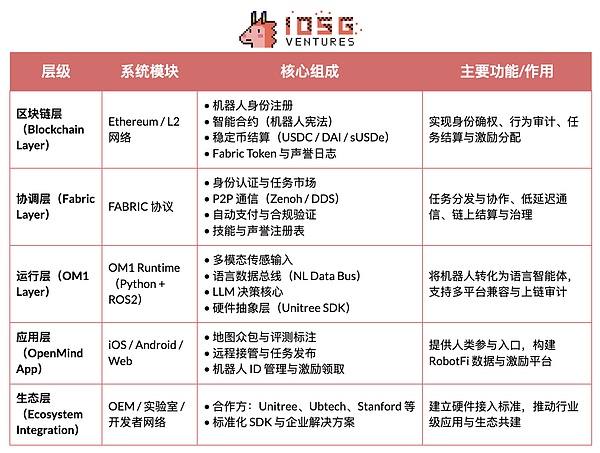
Project Progress and Realistic Assessment
OpenMind is in the early stage of “technologically operational but commercially unavailable”.core systemOM1 Runtime has been open sourced on GitHub. It can run on multiple platforms and supports multi-modal input. It realizes language-to-action task understanding through the Natural Language Data Bus (NLDB). It has high originality but is still experimental. Fabric network and chainSettlement only completes the interface layer design.
Ecologically, the project hasOpen hardware such as Unitree, Ubtech, TurtleBot and Stanford, Oxford, Seoul RoboticsCooperation with other universities is mainly used for education and research verification, and has not yet been industrialized.The app is now in beta, but the incentive and task features are still in their early stages.
In terms of business model, OpenMind has builtOM1 (open source system) + Fabric (settlement protocol) + Skill Marketplace (incentive layer)The three-tier ecosystem currently has no revenue and relies on approximately$20 million in early funding(Pantera, Coinbase Ventures, DCG).Overall, the technology is leading, but commercialization and ecology are still in their infancy. If Fabric is successfully implemented, it is expected to become “Android in the era of embodied intelligence”, but it has a long cycle, high risks, and strong dependence on hardware.
#CodecFlow – The Execution Engine for Robotics
CodecFlow is a decentralized execution layer protocol (Fabric) based on the Solana network. It aims to provide an on-demand running environment for AI agents and robot systems, allowing each agent to have an “Instant Machine”.The core of the project consists of three modules:
-
Fabric: Cross-cloud computing power aggregation layer (Weaver + Shuttle + Gauge) can generate secure virtual machines, GPU containers or robot control nodes for AI tasks in seconds;
-
optr SDK: Agent execution framework (Python interface), used to create “Operators” that can operate desktop, simulation or real robots;
-
Token incentives: The on-chain incentive and payment layer connects computing providers, agent developers and automated task users to form a decentralized computing power and task market.
The core goal of CodecFlow is to create a “decentralized execution base for AI and robot operators” so that any agent can run safely in any environment (Windows/Linux/ROS/MuJoCo/robot controller) to achieve everything fromComputing power scheduling(Fabric) →System environment(System Layer) →perception and action(VLA Operator) common execution architecture.
Project Progress and Realistic Assessment
An earlier version has been releasedFabric framework(Go) withoptr SDK(Python), you can start an isolated computing instance in a web page or command line environment.The Operator Market is expected to be launched at the end of 2025 and is positioned as a decentralized execution layer for AI computing power. Its main service targets include AI developers, robot research teams and automated operation companies.
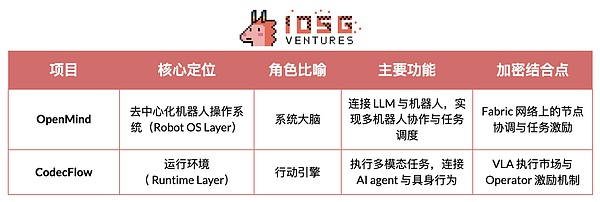
Machine Economy Layer
#BitRobot – The World’s Open Robotics Lab
BitRobot is a software developed for Embodied AI and robots.Decentralized scientific research and collaboration network(Open Robotics Lab), jointly launched by FrodoBots Labs and Protocol Labs.Its core vision is:Through the open architecture of “Subnets + Incentive Mechanism + Verifiable Work (VRW)”, core functions include:
-
Define and verify the true contribution of each robot task through VRW (Verifiable Robotic Work) standards;
-
Give robots on-chain identity and economic responsibility through ENT (Embodied Node Token);
-
Organize cross-regional collaboration among scientific research, computing power, equipment and operators through Subnets;
-
Through Senate + Gandalf AI, we can realize the incentive decision-making and scientific research governance of “human-machine co-governance”.
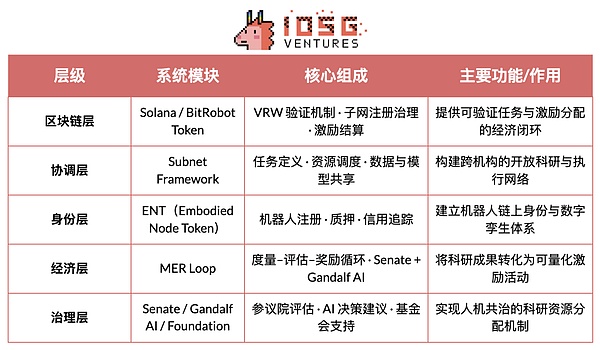
Since the release of the white paper in 2025, BitRobot has run multiple subnets (such as SN/01 ET Fugi, SN/05 SeeSaw by Virtuals Protocol) to achieve decentralized remote control and real-scenario data collection, and launched a $5M Grand Challenges fund to promote scientific research competitions in global model development.
#peaq – The Economy of Things
peaq is a Layer-1 blockchain specifically built for the machine economy, providing underlying capabilities such as machine identity, on-chain wallets, access control, and nanosecond-level time synchronization (Universal Machine Time) for millions of robots and devices.Its Robotics SDK enables developers to make robots “machine economy ready” with minimal code, enabling cross-vendor and cross-system interoperability and interaction.
Currently, peaq has launched the world’s first tokenized robot farm and supports more than 60 real-world machine applications.Its tokenization framework helps robotics companies raise capital for capital-intensive hardware and expand engagement from traditional B2B/B2C to a broader community layer.With a protocol-level incentive pool injected by network fees, peaq can subsidize new device access and support developers, forming an economic flywheel that drives the accelerated expansion of robotics and physics AI projects.

Data Layer
Aimed at solving the problem of scarce and expensive high-quality real-world data in embodied intelligence training.Collect and generate human-computer interaction data through multiple paths, including remote control (PrismaX, BitRobot Network), first-person perspective and motion capture (Mecka, BitRobot Network, Sapien, Vader, NRN), and simulation and synthetic data (BitRobot Network), providing a scalable and generalizable training basis for robot models.
What needs to be clear is, Web3 is not good at “producing data”——In terms of hardware, algorithm and collection efficiency, the Web2 giant far exceeds any DePIN project.Its real value lies inReshape the distribution and incentive mechanism of data.Based on “stable currency payment network + crowdsourcing model”, through a permissionless incentive system and on-chain rights confirmation mechanism, low-cost small-amount settlement, contribution traceability and automatic profit sharing are achieved.However, open crowdsourcing still faces the problem of closed loop between quality and demand – the quality of data is uneven, and there is a lack of effective verification and stable buyers.
#PrismaX
PrismaX is a decentralized remote control and data economic network for embodied intelligence (Embodied AI). It aims to build a “global robot labor market” and allow human operators, robotic equipment and AI models to co-evolve through the on-chain incentive system.The core of the project consists of two major components:
-
Teleoperation Stack——Remote control system (browser/VR interface + SDK), connecting global robotic arms and service robots to achieve real-time human control and data collection;
-
Eval Engine——Data evaluation and verification engine (CLIP + DINOv2 + optical flow semantic scoring), which generates quality scores for each operation trajectory and uploads them to the chain for settlement.
PrismaX transforms human operating behavior into machine learning data through a decentralized incentive mechanism to build aRemote control → data collection → model training → on-chain settlementA complete closed loop to achieve a circular economy in which “human labor is data asset”.
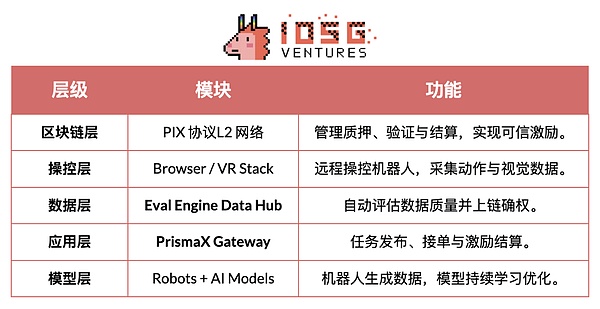
Project Progress and Realistic Assessment
PrismaX has launched a beta version (gateway.prismax.ai) in August 2025. Users can remotely control the robotic arm to perform grasping experiments and generate training data.Eval Engine is already running internally. Overall, PrismaX technology has a high degree of implementation and clear positioning. It is the key middle layer connecting “human operation × AI model × blockchain settlement”.Its long-term potential is expected to become a “decentralized labor and data protocol in the era of embodied intelligence”, but it still faces scale challenges in the short term.
#BitRobot Network
BitRobot Network realizes multi-source data collection such as video, remote control and simulation through its subnet.SN/01 ET Fugi allows users to remotely control the robot to complete tasks and collect navigation and perception data in a “real-life Pokémon Go-style” interaction.This gameplay led to the creation of the FrodoBots-2K dataset, one of the largest open source datasets for human-machine navigation currently used by institutions such as UC Berkeley RAIL and Google DeepMind.SN/05 SeeSaw (Virtual Protocol) uses iPhone to collect first-person video data through large-scale crowdsourcing in real environments.Other announced subnets, such as RoboCap and Rayvo, focus on collecting first-person video data using low-cost physical devices.
#Mecka
Mecka is a robotic data company that uses gamified mobile phone collection and customized hardware devices to crowdsource first-person video, human motion data and task demonstrations to build large-scale multi-modal data sets and support the training of embodied intelligence models.
#Sapien
Sapien is a crowdsourcing platform with “human movement data-driven robot intelligence” as its core. It collects human movement, posture and interaction data through wearable devices and mobile applications for training embodied intelligence models.The project is committed to building the world’s largest human movement data network, making natural human behavior a basic data source for robot learning and generalization.
#Vader
Vader crowdsources first-person videos and task demonstrations through its real-world MMO app EgoPlay: users record daily activities from a first-person perspective and are rewarded with $VADER.Its ORN data pipeline can convert original POV images into privacy-processed structured data sets, including action labels and semantic narratives, which can be directly used for humanoid robot strategy training.
#NRN Agents
A gamified embodied RL data platform that crowdsources human demonstration data through browser-side robot control and simulation competitions.NRN generates long-tail behavioral trajectories through “competitive” tasks, which are used for imitation learning and continuous reinforcement learning, and serve as scalable data primitives to support sim-to-real policy training.
#Embodied intelligent data collection layer project comparison
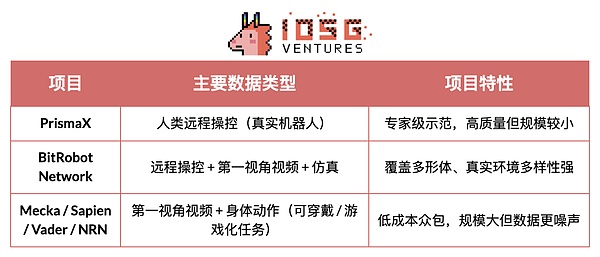
Perception and Simulation (Middleware & Simulation)
The perception and simulation layer provides the core infrastructure for robots to connect the physical world and intelligent decision-making, including positioning, communication, spatial modeling, simulation training and other capabilities. It is the “middle layer skeleton” for building large-scale embodied intelligent systems.Currently, this field is still in the early exploration stage. Each project has formed a differentiated layout in the directions of high-precision positioning, shared space computing, protocol standardization, and distributed simulation. There is no unified standard or interoperable ecosystem yet.
Middleware & Spatial Infra
The core capabilities of robots—navigation, positioning, connectivity, and spatial modeling—form a key bridge between the physical world and intelligent decision-making.While the broader DePIN projects (Silencio, WeatherXM, DIMO) began to refer to “robots,” the following projects are most directly related to embodied intelligence.
#RoboStack – Cloud-Native Robot Operating Stack
RoboStack is a cloud-native robot middleware that realizes real-time scheduling, remote control and cross-platform interoperability of robot tasks through RCP (Robot Context Protocol), and provides cloud simulation, workflow orchestration and Agent access capabilities.
#GEODNET – Decentralized GNSS Network
GEODNET is a global decentralized GNSS network that provides centimeter-level RTK high-precision positioning.Through distributed base stations and on-chain incentives, it provides a real-time “geographic reference layer” for drones, autonomous driving and robots.
#Auki – Posemesh for Spatial Computing
Auki has built a decentralized Posemesh spatial computing network that generates real-time 3D environment maps through crowdsourcing sensors and computing nodes, providing a shared spatial benchmark for AR, robot navigation, and multi-device collaboration.It is the key infrastructure that connects virtual space and real scenes, promoting the integration of AR × Robotics.
#Tashi Network — Real-time grid collaboration network for robots
Decentralized real-time grid network to achieve sub-30ms consensus, low-latency sensor exchange and multi-robot status synchronization.Its MeshNet SDK supports shared SLAM, group collaboration and robust map updates, providing a high-performance real-time collaboration layer for embodied AI.
#Staex — a decentralized connectivity and telemetry network
A decentralized connectivity layer originating from Deutsche Telekom’s R&D arm provides secure communications, trusted telemetry and device-to-cloud routing capabilities, enabling fleets of robots to reliably exchange data and collaborate across different operators.
Simulation and training system (Distributed Simulation & Learning)
#Gradient – Towards Open Intelligence
Gradient is an AI laboratory that builds “Open Intelligence” and is committed to realizing distributed training, reasoning, verification and simulation based on decentralized infrastructure; its current technology stack includes Parallax (distributed reasoning), Echo (distributed reinforcement learning and multi-agent training) and Gradient Cloud (AI solutions for enterprises).In the field of robotics, the Mirage platform provides distributed simulation, dynamic interactive environment and large-scale parallel learning capabilities for embodied intelligence training to accelerate the training of world models and general strategies.Mirage is exploring potential collaboration with NVIDIA on its Newton engine.
Robot asset income layer (RobotFi/RWAiFi)
This layer focuses on the key link of transforming robots from “productive tools” into “financial assets” and builds the financial infrastructure of the machine economy through asset tokenization, income distribution and decentralized governance.Representative projects include:
#XmaquinaDAO – Physical AI DAO
XMAQUINA is a decentralized ecosystem that provides global users with highly liquid participation channels for top humanoid robots and embodied intelligence companies, bringing opportunities that were originally only available to venture capital institutions onto the chain.Its token DEUS is both a liquid index asset and a governance carrier, used to coordinate treasury allocation and ecological development.Through the DAO Portal and Machine Economy Launchpad, the community can jointly hold and support emerging Physical AI projects through the tokenization of machine assets and structured on-chain participation.
#GAIB – The Economic Layer for AI Infrastructure
GAIB is committed to providing a unified economic layer for physical AI infrastructure such as GPUs and robots, connecting decentralized capital with real AI infrastructure assets, and building a verifiable, composable, and profitable intelligent economic system.
In the direction of robots, GAIB does not “sell robot tokens”, but achieves the transformation of “real cash flow → composable income assets on the chain” by financializing robot equipment and operation contracts (RaaS, data collection, remote operation, etc.) on the chain.This system covers hardware financing (financial lease/pledge), operating cash flow (RaaS/data service) and data flow revenue (license/contract), etc., making robot assets and their cash flow measurable, priceable, and tradable.
GAIB uses AID/sAID as a settlement and income carrier, guarantees stable returns through structured risk control mechanisms (over-collateralization, reserves and insurance), and has long-term access to DeFi derivatives and liquidity markets, forming a financial closed loop from “robot assets” to “combinable income assets”.The goal is to become the Economic Backbone of Intelligence in the AI era
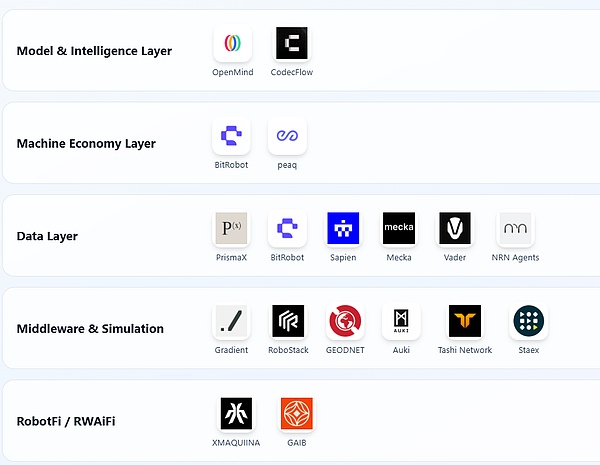
Web3 robot ecological map
Summary and Outlook: Realistic Challenges and Long-term Opportunities
From a long-term perspective,Robot × AI × Web3The integration aims to build a decentralized machine economic system (DeRobot Economy) and promote embodied intelligence from “single-machine automation” to networked collaboration with “confirmable rights, settlementable, and governance”.Its core logic is through “Ttoken → deployment → data → value redistribution“A self-circulating mechanism is formed to enable robots, sensors and computing power nodes to confirm rights, trade and share profits.
However, from a practical perspective, this model is still in the early exploratory stage and is still far from forming a stable cash flow and large-scale commercial closed loop.Most projects remain at the narrative level, with limited actual deployment.Robot manufacturing and operation and maintenance are capital-intensive industries, and token incentives alone cannot support infrastructure expansion. Although on-chain financial design is composable, it has not yet solved the problem of risk pricing and return realization of real assets.Therefore, the so-called “machine network self-circulation” is still ideal, and its business model needs to be verified in reality.
-
Model intelligence layer(Model & Intelligence Layer) is currently the direction with the most long-term value.Open source robot operating systems represented by OpenMind try to break the closed ecosystem and unify multi-robot collaboration and language-to-action interfaces.Its technical vision is clear and the system is complete, but the project volume is huge and the verification cycle is long, and it has not yet formed an industrial-level positive feedback.
-
machine economy layer(Machine Economy Layer) is still in the preliminary stage. In reality, the number of robots is limited, and it is difficult for the DID identity and incentive network to form a self-consistent cycle.We are still far from a “machine labor economy”.In the future, only when embodied intelligence is deployed on a large scale, will the economic effects of on-chain identity, settlement and collaboration networks truly emerge.
-
Data collection layer(Data Layer) The data collection layer has the lowest threshold, but it is currently the closest to commercial feasibility.Embodied intelligent data collection requires extremely high spatiotemporal continuity and action semantic accuracy, which determines its quality and reusability.How to balance “crowdsourcing scale” and “data reliability” is a core challenge in the industry.PrismaX first targets the needs of the B-side, then distributes task collection and verification to provide replicable templates to a certain extent, but the ecological scale and data transactions still require time to accumulate.
-
Perception and simulation layer(Middleware & Simulation Layer) It is still in the technical verification period and lacks unified standards and interfaces to form an interoperable ecosystem.Simulation results are difficult to standardize and transfer to the real environment, and the efficiency of Sim2Real is limited.
-
asset income layer(RobotFi / RWAiFi) Web3 mainly plays an auxiliary role in supply chain finance, equipment leasing and investment governance, improving transparency and settlement efficiency, rather than reshaping industrial logic.
Of course, we believe that the intersection of Robots × AI × Web3 still represents the origin of the next generation of intelligent economic systems.It is not only a fusion of technical paradigms, but also an opportunity to reconstruct production relations: when machines have identities, incentives and governance mechanisms, human-machine collaboration will move from partial automation to networked autonomy.In the short term, this direction is still dominated by narrative and experimentation, but the institutional and incentive framework it has laid is laying the foundation for the economic order of the future machine society.From a long-term perspective, the combination of embodied intelligence and Web3 will reshape the boundaries of value creation—making intelligent agents truly identifiable, collaborative, and profitable economic entities.






